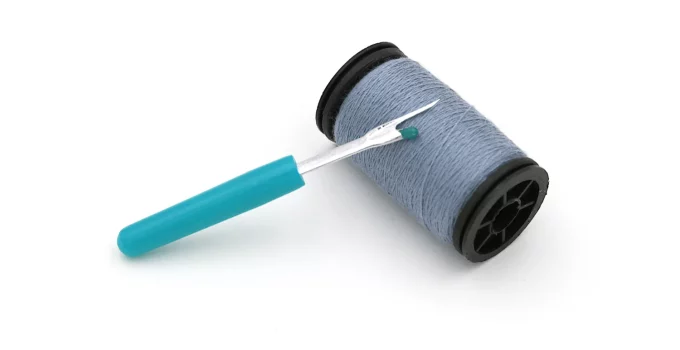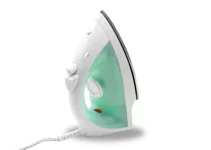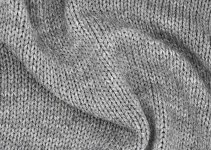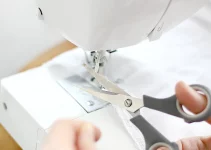It’s fairly easy to find the best seam rippers for sewing, quilting, and embroidery. I’m going to review a few wonderful tools and then we’ll move on to discovering more about this very helpful tool, like what it’s used for and how to use it properly and fast.
A stitch remover tool is an essential tool for beginners and professionals, as well. Beginners will definitely use it to unsew the wrong stitches. But I’m sure that experienced amateurs and professional sewists make mistakes too.
It can also be used to remove hems if you want to modify an object, make it shorter or longer.
Some sewing machines also come with a seam ripper among accessories. It’s especially a frequently included accessory for one famous sewing machine brand, Singer. Among the exceptions is their Singer M1000, which is a sewing machine under 100 dollars.
Even considering all that, chances are that, even if you’re buying a machine, it’s not going to include one in the package. Thus, most people still have to search for the best seam rippers for quilting and other projects.
If you are particularly interested in making amazing quilts, check out my reviews for large throat sewing machines for quilting.
Best Seam Rippers Reviews

We’re lucky that the best seam rippers are fairly cheap tools. You should expect to spend under $10.
Thus, you don’t have to spend much time before buying one or a set. Read these reviews and then you can decide which one is your favorite.
Some are sold in sets, while others are sold as a single piece. We’ll see what each of these selling options offer.
Singer also has a bunch of different models so we’ll have to see which of them end up making our list.
1. Clover White Ergonomic Seam Ripper: Overall the Best Seam Ripper
Why is this the Clover White Ergonomic Seam Ripper my first recommendation as the best seam ripper for quilting, sewing and embroidery?
Because it meets all criteria: sharpness, quality, ergonomic handle, beautiful design, durability, and affordable price.
First of all, I absolutely love the way this model looks.
It’s a classic design when it comes to the blade, the expected u blade. But the handle is quite beautiful. The white handle with just a splash of black is gorgeous.
The ergonomic shape ensures that you’ll find it comfortable to hold and work with for unsewing stitches from any project.
However, the handle will amount to zero if we don’t get a sharp blade. The purpose of a seam ripper is to make our projects easier to accomplish with perfection, not to frustrate us.
This Clover model does have a very sharp curve that will cut through threads.
It can be used on delicate, tiny stitches with the same precision because it’s a model with smaller sides and a very sharp curve.
This one has a sharp enough blade to cut even through jeans like they’re the lightest material.
Overall, Clover is at the top when it comes to the best brands of seam rippers. And their white ergonomic model should be checked out first. You can’t beat the quality, the sharpness, the cheap price and the ergonomic handle.
2. Riveda Premium Seam Ripper: Best Value for Money
I’m partial to the first model that I reviewed just above. However, that doesn’t mean that there aren’t other choices that we should consider as the best seam rippers.
One of those choices is this Riveda, which actually includes 2 rippers for basically the price of one.
We get a larger tool with a flat handle that measures 5.5 inches. This flat handle doesn’t look like the most ergonomic one on the planet but it won’t cause major inconveniences either.
The smaller ripper of 3.5 inches looks adorable. It’s really tiny and it has a round handle.
The smaller one will be awesome for tight stitches where thicker blades have a harder time penetrating without potentially damaging the fabric.
Riveda ensures us that their handle design makes it extremely easy to hold and apply force with comfort.
Well, you won’t have to apply too much force because both these stitch remover tools from Riveda come with sharp blades.
There are just a few complaints of dull blades out of hundreds and hundreds of absolutely positive reviews. I certainly call that a winner.
It’s hard two find a set of 2 seam rippers of different sizes for this price tag, given their quality and sharpness. That’s why this Riveda set ends up being my second favorite.
Both come with clear caps for safe storage.
3. Dritz 638 Deluxe Seam Ripper
Overall, the Dritz 638 Deluxe Seam Ripper offers exactly what we should be looking for when shopping for the best seam ripper for quilting, sewing and embroidery.
It’s affordable, of good quality, sharp, has a good handle, and it has the classic design.
So, how come it’s not my absolute favorite?
Because there are complaints about it being dull. A dull seam ripper is completely unusable.
I’m completely aware that those who mentioned that they received a dull blade were just a few. Even so, I wanted to warn you so that you know the potential risks.
Overall, I still consider it to be a solid choice as one of the best seam rippers for quilting, sewing and embroidery. But it’s certainly not my favorite and not my first recommendation.
Nevertheless, I still love this manufacturer for a variety of sewing tools, I even included one of their products for my reviews for the best French curve ruler set.
4. Clover Seam Ripper
Since Clover is one of the best brands for the best seam rippers, it’s to be expected that I would want to review another model from them.
The blade is pretty much the same, we get the same sharpness and impressive capability to remove all types of stitches.
The way I see it, the differences lie in the design of the handle.
This one has a brown flat handle instead of a white round one. I certainly like the white ergonomic handle a lot more.
Moreover, it seems that some people have the wrong impression that just because the handle is brown, then that automatically means that it’s made of wood.
Even from the pictures, it looks like plastic to me but I can see why someone might assume that this must be made from wood if they just look at the picture for a second.
Nevertheless, it’s nowhere mentioned that this is a wooden handle. Thus, if you were looking for a wooden handle, don’t get this Clover. It’s made of plastic.
However, if you’re looking for a cheap price and quality and sharpness that exceeds the cost, Clover is a very good choice.
5. Singer Grip N Rip Seam Ripper (Thimble Included)
I’m a bit disappointed to tell you that Singer is not the manufacturer for some of the best seam rippers.
Actually, this Grip N Rip model is the only one from Singer that I actually like a lot. The others are either dull or of poor quality, with instances where the handle breaks during the first use.
Well, the Grip N Rip is not only of acceptable quality but it also includes an accessory.
It’s a bit pricey for what it offers. If you’re not particularly interested in the accessory that comes with this Singer, I recommend checking out other options like Clover, Sullivans, and Riveda.
The accessory in question is a comfort fit gel thimble. The thimble is adjustable in size.
I’m not exactly sure how many people are in search of a seam ripper that also comes with a gel thimble but it’s always nice to offer all kinds of alternatives.
Some users praise the handle. It doesn’t exactly look like being the most comfortable thing but we can be reassured that it will be easy to use this stitch remover tool.
The sharpness is top-notch, too. It has the potential to last for years to come, as long as you don’t lose it.
6. Sullivans Precision Seam Ripper with Buttonhole Cutter: One of the Sharpest Seam Rippers
You might believe that I’m excited about this Sullivans set because it includes a buttonhole cutter but you’d be wrong.
There’s one particular thing that I’m excited about: this model is incredibly sharp. It might be one of the sharpest cutters that you’ll ever buy.
Considering that some Singer models and many others receive complaints that they’re dull, you won’t find that problem here.
The blade is really sharp. That means that it can cut through threads without force. I absolutely view it as a great choice for the best seam ripper for quilting, sewing and embroidery.
On the other hand, it also means that you have to pay attention when using it so that you don’t cut the fabrics instead of unsewing stitches.
I should also add that this doesn’t have the classic design of a seam ripper.
Different design
It looks like a small scalpel with a plastic handle. The handle is not the sturdiest and doesn’t offer impressive ergonomics. But we do get a very sharp blade and that, in my opinion, makes the price worth it.
In the package, we also get an additional blade for the ripper.
And the buttonhole cutter. You can use a ripper as a buttonhole cutter but I guess it will be much faster to do it with a specially designed buttonhole cutter.
The buttonhole cutter will be attached to the same plastic handle that holds the ripper blade. Thus, these are changeable razor sharp blades.
There’s also a protective safety case included.
7. Famore Easy Glide Surgical Seam Ripper
If you want something completely different from the classic best seam rippers, then maybe you’ll be excited to discover this model from Famore.
It sort of looks like a scalpel so it’s not even close to the classic design.
The entire metal design looks a bit intimidating. But that same intimidating look can also inspire confidence in its ability as a stitch remover tool.
Would I consider using a tool like this? I’m not sure. When you get used to one design, some people might not be willing to try something that is completely different.
However, this Famore Easy Glide Surgical Seam Ripper has a bunch of enthusiastic reviews that made me recommend it. Especially since some mention that they have been using one of these for years.
It has one handle, 2 replaceable blades and 1 safety cover for storage.
The whole thing, the handle and the blades, is made from high grade steel. Considering that, you can understand why the price is higher than what you might expect.
Contrary to the stainless steel design, this tool is actually comfortable to use as long as you understand how sharp it is. It is surgically sharp. Just like Sullivans, this Famore stitch remover tool is one of the sharpest on this list.
8. OttLite Seam Ripper with LED Magnifier
I wanted to include this particular model because it comes with a LED magnifier. That’s certainly something different.
It might turn out to be an interesting addition for some potential buyers who have felt the need to use a magnifier in the past.
In addition to the magnifier, we also get a LED light. That certainly completes the package and I really like this addition.
I also like a lot the fact that two CR2032 batteries are included, which are needed for the LED light. I’m always disappointed when a product doesn’t include batteries if it needs them to work.
Given all that we get, the high price is quite expected. We could buy about 4 classic rippers that don’t include a LED magnifier.
It has a 3x optical-grade magnifier lens and the ripper area rotates 360 degrees.
Although this OttLite Seam Ripper with LED Magnifier is highly appreciated by users, we are also warned that it can take a bit of time until we learn how to use it properly and without tripping over the addition of a magnifier with light.
9. Singer Sewer’s Mate Multi Tool
This storage case that comes with 11 tools addresses a main category of buyers: those who own a Singer sewing machine and that could benefit from these additional tools.
The 11 tools included in this set are: needle inserter, needle threader, thread cutter, magnifier, lint brush, awl, 2 seam rippers, and 3 screwdrivers.
There’s actually only one handle and the two 2 seam rippers are diametrically opposed on the same handle. I don’t understand that when they could have made 2 separate blades, each with their own handle.
The difference between the 2 is that one has longer sides, while the other is smaller in size.
If you’re looking for the exact same thing, a set with 2 seam rippers of different size but each with its own separate handle and if you don’t care much about this Singer set, then you can check out the set from Riveda that I reviewed above.
Seam Ripper Uses

Just as the name suggests, a seam ripper is used to remove stitches, cut threads, open seams and buttonholes.
Thus, people who undertake sewing actually use this tiny tool to unsew stitches and threads for various reasons.
It’s used by those who hand sew or use a sewing machine.
You can even take a pair of jeans apart by using a seam ripper. You can unstitch the hem of the jeans by sliding the blade of the ripper under the hem along the stitches. Moreover, you can also use the blade of a ripper to cut through the side seam if they’ve been pressed open.
If you’re in a pinch and you don’t have this specific tool, you can consider using a substitute. You can use a pair of embroidery scissors. Or use a small very sharp pair of scissors with long, slender, pointy blade tips.
I also saw someone using a scalpel and a single edge razor to cut apart seams and stitching. I personally wouldn’t attempt it because it requires a lot more precision and concentration than the ease with which a seam ripper can be used.
Thus, if you want to unstitch fabric or you want to cut threads without damaging the fabric, a seam ripper is the sewing tool to have in your kit.
Types
The most popular and common is the seam ripper that has the blade shaped as a “u”. This is the classic, very efficient, very easy to use.
The “u” shaped ripper consists of a longer side that goes under the stitch. The smaller side usually has a plastic ball at the end for protection.
These two sides, one longer and one shorter, create a curve that’s very sharp. The curve is the part that cuts through the thread and unsews stitches.
Thus, the focus is on only one type of seam rippers.
Where they mostly differ is in the shape of the handle, the material the handle is made from, and the length of the handle.
The thickness of the cutting point can also differ among various models.
The other completely different category is that of electric seam rippers. I did my research and I tried to find a good electric model but it wasn’t possible. We’ll continue to remain old-fashioned and do our stitches removal manually.
How to Use a Seam Ripper
The tip of the tool and the curve of the ripper are the two parts used to remove the stitches between two pieces of fabric. I also gave you that jeans example to show you that the blade can be helpful as well.
However, if we want to unsew stitches, then the tip and that very sharp curve of the seam ripper are used.
Start at one end of the stitches you want to unsew.
Insert the tip under the stitches, holding the ripper sideways. Gently insert the tip under the stitches so that you don’t poke your fabric.
Push the seam ripper forward until the curve of the ripper cuts the threads. In order to get the curve to cut the thread, just pull the ripper a bit upwards and away from the fabric. Now, go to the next stitch and repeat the movement.
This method of removing stitches also applies when you’re removing quilt stitching with a seam ripper.
Once you have a few stitches removed with the seam ripper, if the thread is not too thick, you can pull the two fabrics apart with your hand and your seam ripper if you’re doing it right.
If you need a visual guide for this method, check out this YouTube video. It’s short and helpful.
Don’t ruin the fabric
Some people use the seam ripper in an aggressive manner and they can risk ripping the fabric not only the stitches.
For example, if you stick the ripper between two fabrics and then slice with the ripper where they’re sewn together, it’s possible that you’ll ruin your fabric. You can tear through fabric with a seam ripper because the blade is very sharp. If it’s not very sharp then it’s not good.
You need to use the seam ripper on the stitches, mostly one by one if you want to do it right. Using this tool is very easy, especially when you’re using some of the best seam rippers and you have a bit of patience.




